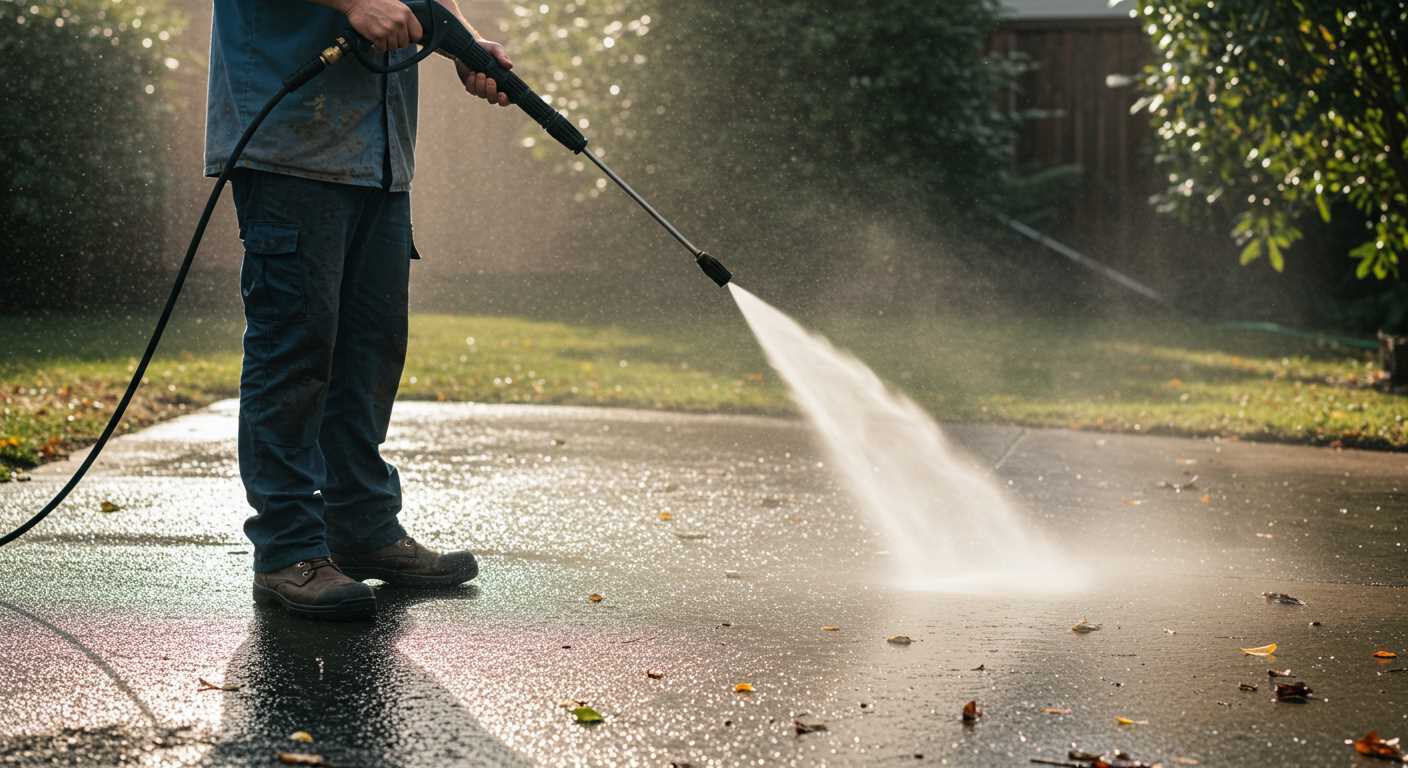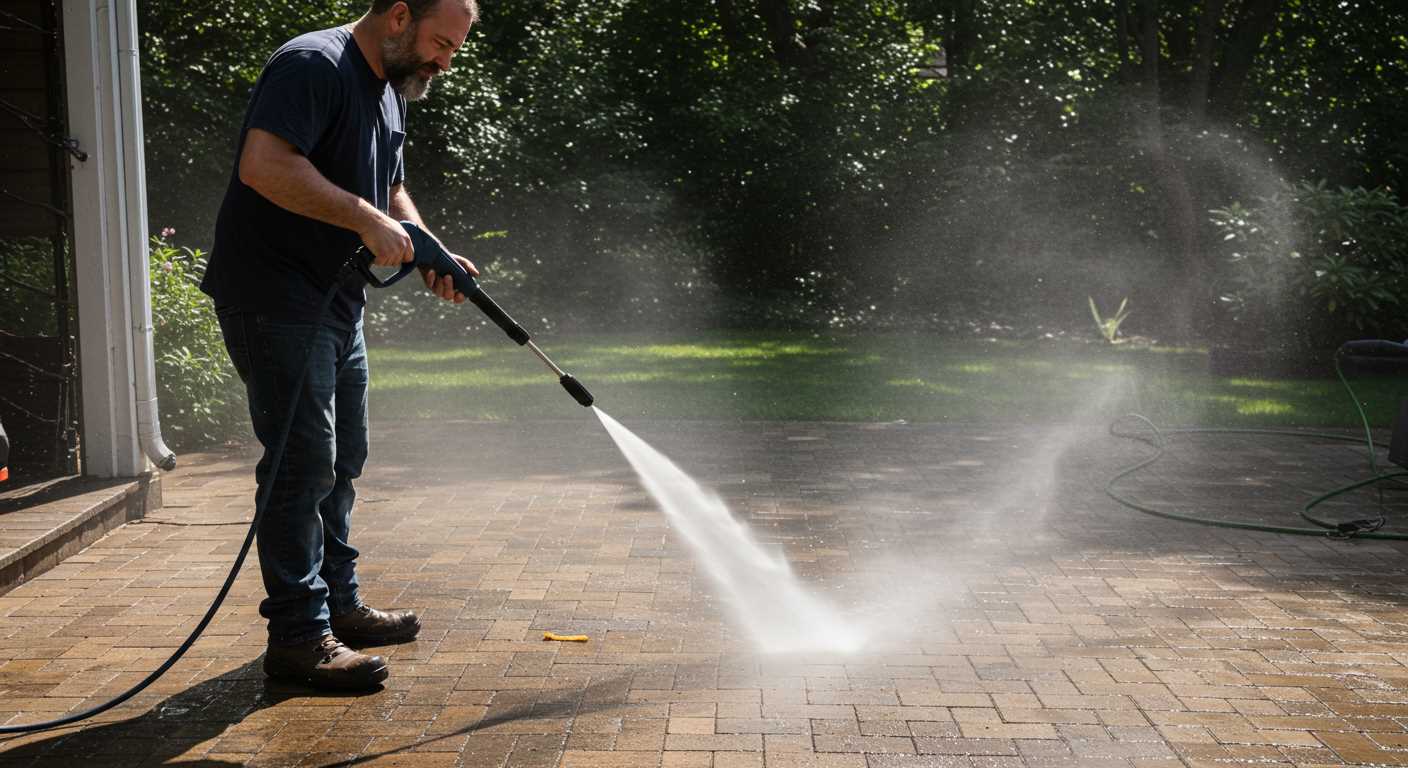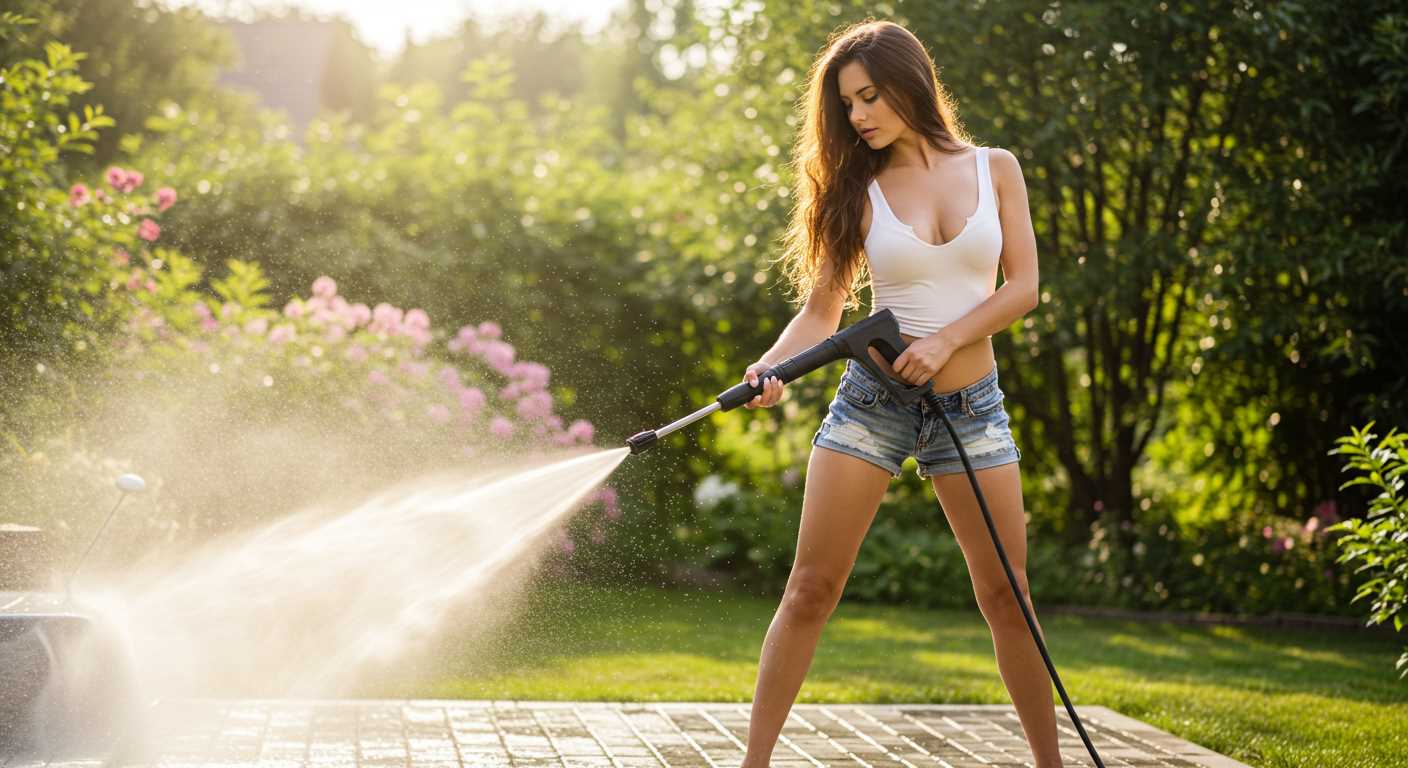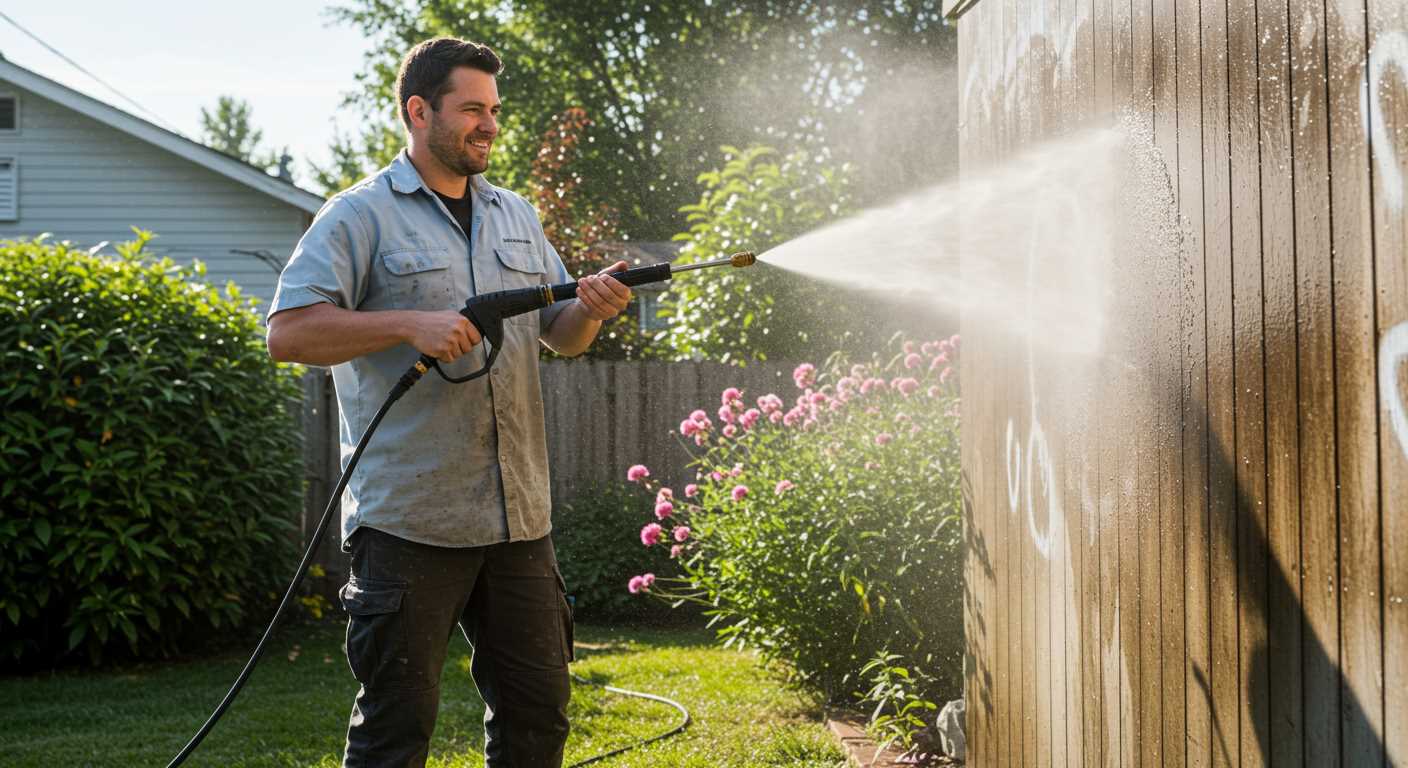




Begin with a simple mixture of warm water and dish soap. This solution works wonders for removing grime and stains from various surfaces. Use a sturdy scrub brush or a sponge to apply the mixture, focusing on areas with stubborn dirt. For tougher spots, let the soapy water sit for a few minutes before scrubbing.
For wooden decks or fences, a blend of vinegar and water can be highly effective. Combine one part vinegar with three parts water in a bucket, and apply it with a brush. This not only cleans but also helps to eliminate mould and mildew. Rinse thoroughly with a hose to remove any residue.
Concrete surfaces can benefit from baking soda. Sprinkle it generously over the area, then spray with water to create a paste. Scrub with a stiff-bristle brush to lift stains. This method is particularly useful for patios and driveways. Rinse well to reveal a refreshed surface.
Don’t overlook the power of a simple garden hose. A good nozzle can provide sufficient force to dislodge dirt. Aim for crevices and corners where debris accumulates. Regular rinsing helps maintain cleanliness and prevents build-up over time.
Always remember to wear protective gear, especially gloves and goggles, when working with cleaning solutions. This ensures safety while tackling those tough jobs. By using these techniques, you can achieve a sparkling exterior without the need for heavy machinery.
Choosing the Right Cleaning Solutions for Exterior Surfaces
For effective maintenance of your exterior surfaces, selecting the appropriate solutions is key. Here’s a concise guide to various options based on my experience.
- All-Purpose Cleaners: These are versatile and can tackle dirt, grime, and stains on many surfaces. Look for biodegradable options to minimise environmental impact.
- Vinegar: A natural disinfectant that works wonders against mildew and mould. Mix equal parts of vinegar and water for a simple yet powerful solution.
- Baking Soda: Excellent for scrubbing tough stains. Create a paste with water and apply it on affected areas, letting it sit before scrubbing.
- Oxygen Bleach: Safer than chlorine bleach, this option effectively removes stains and brightens surfaces. It’s particularly useful on concrete and wood.
- Dish Soap: Ideal for light duties, it can help lift grease and grime. Combine with warm water for enhanced performance.
When choosing a solution, consider the surface material. For instance:
- Wood: Avoid harsh chemicals; opt for gentle cleaners to prevent damage.
- Concrete: Sturdy and can handle stronger solutions, including diluted bleach if necessary.
- Vinyl: Use mild detergents to maintain its appearance and prevent discolouration.
Always test any solution on a small, inconspicuous area first. This way, you can ensure it won’t cause any unwanted damage or discolouration. From my experience, patience and the right products can yield remarkable results, making your surfaces look as good as new.
Preparing the area: removing furniture and obstacles
Before commencing any cleaning task, it’s crucial to create a clear workspace. Start by relocating any furniture, planters, or decorative items that might obstruct your efforts. This not only ensures safety but also prevents potential damage to your belongings.
For instance, I once made the mistake of overlooking a garden bench while tackling grime on a patio. The result? A stubborn stain on the bench that took weeks to fade. So, take a few minutes to survey the area and remove anything that could get in the way.
Assessing the space
Walk around the perimeter to identify obstacles. Look for items like hoses, toys, or garden tools that might be lying around. Consider moving any outdoor rugs or mats as they can trap dirt and moisture. If you have potted plants, consider temporarily relocating them to a shaded area to protect them from any splashes or cleaning solutions.
Protecting surfaces
Once the area is clear, think about protecting surfaces that may be sensitive to cleaning agents. Cover nearby plants with tarps or old sheets to shield them from chemical exposure. If you’re working on a deck or patio, consider using painter’s tape to mask off any edges or areas you want to avoid applying solutions to. This preparation reduces the risk of damage and ensures a more thorough and safe outcome.
Using a garden hose: techniques for optimal water flow
For achieving maximum efficiency with a garden hose, ensure that the nozzle you choose provides adjustable settings. A nozzle with a fan spray can cover larger areas, while a concentrated stream is ideal for stubborn dirt. Attach a trigger nozzle to control the water flow, which helps conserve water while allowing you to direct it precisely where needed.
Adjusting Water Pressure
Consider the source pressure. If you’re working with a standard residential setup, the pressure might be lower than what a pressure washer delivers. To enhance the force, reduce the length of the hose; longer hoses can decrease water flow due to friction losses. If you notice weak flow, check for kinks or blockages in the hose.
Technique Application
When applying water, start from the top of the surface and work your way down. This method prevents dirt from settling onto already cleaned areas. For vertical surfaces like walls, maintain a consistent distance of about 30-60 cm from the surface to avoid splashing and achieve an even spread. Use sweeping motions to ensure thorough coverage and avoid concentrating water in one spot for too long.
In addition to these techniques, pairing your garden hose with suitable cleaning solutions can enhance results. For instance, a mix of water and vinegar can tackle algae on driveways effectively. If you’re curious about other areas of life, you might find it interesting to check out whether are digital cameras allowed on airplanes for your next trip.
Scrubbing Techniques for Different Types of Surfaces
For effective scrubbing, tailor your approach based on the surface material. Here are specific techniques for various surfaces:
-
Wooden Decks:
- Use a soft-bristled brush to avoid damaging the wood.
- Apply a mixture of warm water and mild detergent, scrubbing along the grain.
- Rinse thoroughly with a garden hose to remove any soap residue.
-
Vinyl Siding:
- Opt for a medium-bristled brush to effectively lift dirt.
- Combine equal parts vinegar and water for a natural solution.
- Work in sections, rinsing after scrubbing to prevent streaks.
-
Concrete Pathways:
- Use a stiff-bristled broom for initial debris removal.
- Create a paste with baking soda and water to tackle stubborn stains.
- Scrub with a heavy-duty brush, focusing on stained areas, then rinse well.
-
Brick Walls:
- Employ a wire brush for tough grime, but be cautious to avoid damaging the mortar.
- A mixture of water and dish soap works well; scrub using a circular motion.
- Rinse with gentle water flow, ensuring no soap is left behind.
-
Metal Railings:
- Use a non-abrasive sponge for a gentle clean.
- Mix water with a few drops of dish soap; scrub thoroughly.
- Wipe down with a damp cloth to eliminate any soap residue.
These methods, based on surface type, ensure thorough scrubbing while preserving the integrity of your exterior materials. Adjust your tools and solutions as necessary to achieve optimal results.
Cleaning Windows and Doors Without Streaks

For achieving streak-free results on glass surfaces, I recommend using a mixture of distilled water and white vinegar in a spray bottle. This solution effectively cuts through grime without leaving residues. Use a 50/50 ratio for optimal results. Avoid using tap water, as minerals can cause streaking.
Next, equip yourself with a quality microfiber cloth. These are superior to paper towels or cotton rags, as they trap dirt and moisture without scratching the surface. Always ensure the cloth is clean before use, as dirt on the cloth can lead to unsightly marks.
To apply the solution, spray it directly onto the glass, starting from the top and working your way down. This method prevents drips from settling on already cleaned areas. For larger windows, consider using a squeegee. After spraying, pull the squeegee down in a straight line, wiping the blade with the microfiber cloth after each pass to prevent streaks.
For frames and sills, I suggest using a soft-bristle brush dipped in soapy water. This helps to lift dirt without scratching. Rinse with a damp cloth afterwards to remove any soap residue, which can also cause streaking.
Finally, avoid cleaning windows in direct sunlight, as this can cause cleaning solutions to dry too quickly, resulting in streaks. Instead, choose a cloudy day or work in shaded areas.
| Tip | Description |
|---|---|
| Solution Ratio | 50% distilled water, 50% white vinegar |
| Cloth Type | Microfiber for no scratches |
| Application Method | Spray top to bottom, use a squeegee |
| Frame Cleaning | Soft-bristle brush with soapy water |
| Best Time | Cloudy days or shaded areas |
Removing stubborn stains and mildew manually
For those persistent marks and mildew, a good approach is to use a mixture of baking soda and vinegar. Combine half a cup of baking soda with a quarter cup of white vinegar. Apply this paste directly to the stained area, allowing it to sit for about 15 minutes. The reaction between the two ingredients works wonders on tough spots.
Scrubbing with the right tools
Use a stiff-bristled brush or a scrub pad, depending on the surface you’re tackling. For concrete or brick, a stiff brush is ideal, while softer surfaces like wood may require a gentler scrubbing pad to avoid damage. Always scrub in a circular motion to lift stains effectively.
Addressing mildew specifically
For mildew, a solution of one part bleach to three parts water can be particularly effective. Apply this mixture with a spray bottle, ensuring you wear gloves and a mask to protect yourself from fumes. Let it sit for about 10 minutes before scrubbing. Rinse thoroughly with clean water to remove any residue, as leftover bleach can harm surrounding plants.
Finishing touches: rinsing and drying methods
After tackling the exterior surfaces, focus on rinsing and drying to achieve a polished look. Begin by using a garden hose equipped with a spray nozzle to rinse off any remaining cleaning solution. Aim for a gentle yet steady stream to avoid damaging delicate areas. Move systematically from top to bottom, ensuring every section is thoroughly rinsed. This method prevents soap residue from drying and leaving streaks.
Optimal drying techniques
For drying, consider using microfibre cloths or soft towels that won’t scratch surfaces. For large areas like patios or driveways, allow nature to take its course on a sunny day. However, if you’re in a hurry or dealing with a humid climate, a leaf blower can expedite the process by blowing away excess water. In tight spots, such as corners or around fixtures, a squeegee can be useful to remove puddles effectively.
Final inspection
After drying, conduct a thorough inspection. Look for missed spots or streaks, particularly on windows and doors. If you notice any, a quick go-over with a damp cloth can rectify this. For thorough results across all surfaces, it may be beneficial to learn about different cleaning options. Explore resources like electric vs gas pressure washer which is right for you to determine if investing in powered equipment makes sense for your future projects.
FAQ:
What are some effective methods to clean the outside of my house without using a pressure washer?
You can clean the exterior of your house using a variety of methods. One popular approach is to use a solution of warm water and mild detergent. Simply mix the detergent with water, apply it to the surface with a sponge or soft brush, and rinse it off with a hose. For tougher stains, you can create a mixture of vinegar and water or use baking soda paste. Scrubbing with these solutions can help remove dirt and grime without damaging the surfaces. Additionally, using a garden sprayer can help apply cleaning solutions more evenly.
How can I clean windows on the outside without a pressure washer?
To clean windows without a pressure washer, you can use a simple mixture of water and a few drops of dish soap. Use a sponge or a soft cloth to apply the solution to the glass, scrubbing gently to remove dirt and grime. Afterward, rinse with clean water or use a squeegee for a streak-free finish. For hard-to-reach areas, consider using a long-handled window cleaning tool or a microfiber cloth attached to an extendable pole.
What homemade cleaning solutions can I use for exterior walls?
Homemade cleaning solutions for exterior walls can be quite effective. One option is to mix equal parts of vinegar and water in a spray bottle. This solution can help break down dirt and mildew. Another effective mixture is baking soda and water, which can be applied as a paste to stubborn stains. For tougher jobs, consider using a mixture of bleach (diluted with water) but be cautious around plants and other surfaces, as it can cause damage. Always test a small area first.
How often should I clean the exterior of my house?
The frequency of cleaning the exterior of your house can depend on various factors such as your location and the surrounding environment. Generally, it’s a good idea to do a thorough cleaning at least once a year. However, if you live in a particularly dusty area, near the coast, or where there is a lot of pollen, you may want to clean your home more frequently, perhaps every six months. Regular maintenance can help prevent build-up and keep your home looking fresh.
Are there any specific tools I need for cleaning the outside of my house?
For cleaning the outside of your house without a pressure washer, you will need some basic tools. A sturdy ladder is essential for reaching high areas safely. Soft brushes or sponges are great for applying cleaning solutions to surfaces without causing damage. A bucket for mixing your cleaning solutions is also helpful. Additionally, a garden hose with a spray nozzle can be useful for rinsing off dirt and cleaning solutions. For windows, a squeegee and microfiber cloths will help achieve a streak-free shine.





.jpg)


